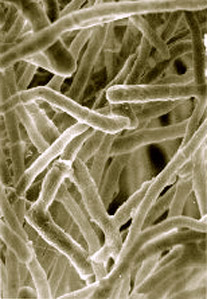User:Fungalphobia/Sandbox
| Trichoderma reesei | |
|---|---|

| |
| Scientific classification | |
| Kingdom: | |
| Division: | |
| Subdivision: | |
| Class: | |
| Order: | |
| Family: | |
| Genus: | |
| Species: | T. reesei
|
| Binomial name | |
| Trichoderma reesei | |
Trichoderma reesei (anamorph Hypocrea jecorina) is a mesophilic filamentous fungus. The laboratory progenitor strain, QM6a, was isolated by the US Army in Boganville during World War II from canvas tents. T. reesei has been extensively studied due to the capacity to secrete large amounts of cellulolytic enzymes (cellulases and hemicellulases).
Microbial cellulases have industrial application in the conversion of cellulose, a major component of plant biomass, into glucose.[1]
Recent advances in the biochemistry of cellulase enzymology, the mechanism of cellulose hydrolysis (cellulolysis), strain improvement, molecular cloning and process engineering are bringing T. reesei cellulases closer to being a commercially viable route to cellulose hydrolysis.[2] Several industrially useful strains have been developed and characterised, e.g. Rut-C30[3], RL-P37 and MCG-80. The genome of this organism was released in 2008.[4] This organism also has a mating type dependent characterised sexual cycle.[5]
References
[edit]- ^ Kumar R, Singh S, Singh OV (May 2008). "Bioconversion of lignocellulosic biomass: biochemical and molecular perspectives". J. Ind. Microbiol. Biotechnol. 35 (5): 377–91. doi:10.1007/s10295-008-0327-8. PMID 18338189.
{{cite journal}}: CS1 maint: date and year (link) CS1 maint: multiple names: authors list (link) - ^ Viikari L, Alapuranen M, Puranen T, Vehmaanperä J, Siika-Aho M (2007). "Thermostable enzymes in lignocellulose hydrolysis". Adv. Biochem. Eng. Biotechnol. Advances in Biochemical Engineering/Biotechnology. 108: 121–45. doi:10.1007/10_2007_065. ISBN 978-3-540-73650-9. PMID 17589813.
{{cite journal}}: CS1 maint: multiple names: authors list (link) - ^ [Seidl V, Gamauf C, Druzhinina IS, Seiboth B, Hartl L, Kubicek CP (2008). "The Hypocrea jecorina (Trichoderma reesei) hypercellulolytic mutant RUT C30 lacks a 85 kb (29 gene-encoding) region of the wild-type genome". BMC Genomics. 9: 327. doi:10.1186/1471-2164-9-327. PMC 2483294. PMID 18620557.
{{cite journal}}: CS1 maint: multiple names: authors list (link) CS1 maint: unflagged free DOI (link) - ^ Martinez D, Berka RM, Henrissat B; et al. (May 2008). "Genome sequencing and analysis of the biomass-degrading fungus Trichoderma reesei (syn. Hypocrea jecorina)". Nat. Biotechnol. 26 (5): 553–60. doi:10.1038/nbt1403. PMID 18454138.
{{cite journal}}: Explicit use of et al. in:|author=(help)CS1 maint: date and year (link) CS1 maint: multiple names: authors list (link) - ^ [Seidl V, Seibel C, Kubicek CP, Schmoll M. (2009). "Sexual development in the industrial workhorse Trichoderma reesei". PNAS. 106 (33): 13909–13914. doi:10.1073/pnas.0904936106. PMC 2728994. PMID 19667182.
{{cite journal}}: CS1 maint: multiple names: authors list (link)
